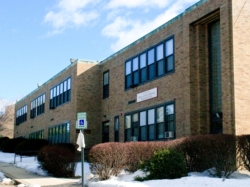MAM program settles into new home
BRIGHTON -- After occupying interim space since the archdiocese sold the majority of its Brighton property to Boston College last July, the St. John’s Seminary Masters of Art in Ministry program finally has a new home.
Faculty, students and alumni volunteers moved the program last month from its interim location in the Creagh Library on the grounds of archdiocese’s former Brighton Chancery, to the former St. Gabriel’s School in Brighton, a space that program organizers hope will provide long-term stability.
Located only a mile from the seminary, MAM’s new location provides its over 100 students with a bright and welcoming space to call their own, said MAM Director Aldona Lingertat.
“As students came in, they were really happy to see our sign on the wall of the building and directing them to parking,” she said. “They felt that finally this was their space; it was like they belonged here. “
The students, most affected by the program’s turbulent relocation history, reacted to the recent move with a hint of nostalgia, yet applauded the faculty’s efforts at making the transition as seemless as possible.
One first-year student, Jeff Cahill, said it was difficult leaving the seminary’s beautiful and holy grounds, but said the new space coordinates everything one could want in a program -- space for prayer, education and friendship.
“Coming here, seeing the work that they have done, you definitely feel that Christ is present in the hallways,” said Cahill.
“The program is still the same, even though the location is different,” he added.
With more elbowroom and its promise of permanence, Lingertat said that the new space allows opportunity for growth and expansion of the program and its offerings, citing certificate programs as one potential option.
“We are also looking into having technology installed to tape our classes, and making them available online, so students can learn more about their faith via distance learning,” said Lingertat.
In addition, Lingertat said, the building’s more expansive accommodations will enable various archdiocesan pastoral offices to hold any workshops and classes they might offer.
While the move away from the St. John’s Seminary campus poses some challenges, Lingertat said that she expects the excitement of what the new space offers to be the greater draw.
“We envision this as being an educational center -- for ministry, for theological studies, for whatever it could become,” said Maryellen Lenihan, MAM’s office manager.
Despite the on-going construction and plethora of boxes yet to be moved from storage, Lingertat and Lenihan have worked hard to ensure their students feel at home in their new space.
First-year student Kay E. Kociuba said she feels at home in the new space that is now filled with green plants that line the central hallway and auditorium.
“It really makes you feel like you are where you are supposed to be,” she said.
“It is just such a gift to be in this program,” said Kociuba, adding, “that we just need to overlook the small adjustments that accompany our move here.”
Lingertat and Lenihan look to the program’s future as they prepare for the Lay Ecclesial Ministries Co-Workers in the Vineyard of the Lord Conference in March and the graduation in May. With 80 graduates so far, the nearly 20 set to graduate this spring will allow the program to ring in its tenth anniversary next fall with close to 100 Master of Arts in Ministry alumni.
To prepare for the occasion, they have imbued the new space with an air of historical continuity, as a tribute to its alumni and a reminder to current students of the legacy they are helping build.
Each of the three classrooms inside 139 Washington Street bear the name of an earlier MAM location -- St. Clement’s Hall, St. Williams Hall and Bishop Peterson Hall. Adorning the walls of each classroom are photographs of the buildings they are named for and the students who studied there, as well as student artwork.
MAM’s four-pillared program structure aims to build a supportive community of laity by fostering their intellectual, spiritual, pastoral and human formation through 11 core courses, four electives and 100 hours of field education per year.
“Our program is not just about course work but about the development of the whole human person, and one that encourages laity to form strong friendships and ties that will continue after graduation,” said Lingertat. “So education isn’t only happening in the classroom. It is happening during break times, before and after class, in our formation evenings and outside of school.”
“What is great about the program is that you are with people who want to be here and have a desire to learn. We are here to work together towards the same goal: to do the Lord’s work,” said Sue Gormley, a first-year student from Westford.



















